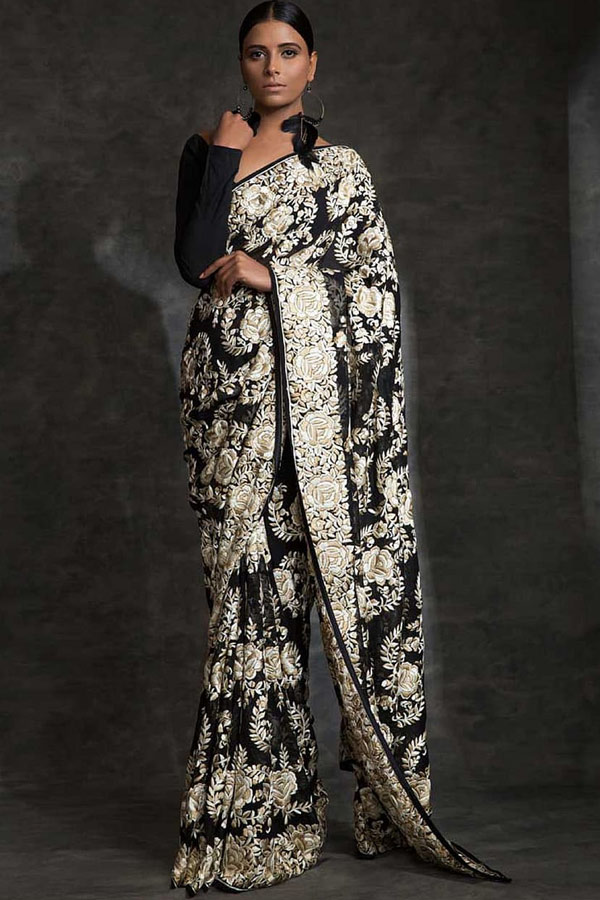The Parsi Gara embroidery is a result of influences from a lot of regions. In the 8th century, the Parsis migrated from Persia and settled down in Gujarat and many other parts of India, thus paving the way for Parsi Gara embroidery. When Arabs invaded Iran, the Parsis were driven out of Persia and they reached the Western coast of India using the sea route. The largest group reached Sanjan in Gujarat. The Hindu king of that time, Jadi Rana, agreed to give them refuge in his kingdom, provided the Parsis learn their language and adopt their attire. This is how the Parsis came to speak Gujrati and wear the saree.
The Parsis used the sea route and ventured to China for trade. When they came back, they got many things like ceramics, antiques and embroidered fabric from China. The embroidered fabrics inspired the Parsi women and they started embroidering patterns on their sarees by themselves. The birth of Gara embroidery happened when the silk fabrics and the embroidery technique from China combined with Parsi and Indian motifs. Gara embroidery is an amalgamation of various styles and cultures, it is rare and treasure worthy.
Gara – Meaning
Apparently, the word Gara (also Ghara) comes from the Gujarati word for a saree. But now, it has come to mean a saree that particularly has an Indian Zoroastrian (Parsi or Irani) style of embroidery. And under the Parsi patronage, the saree with Gara embroidery has become popular as the Parsi sarees.
The Art of Parsi Gara
Material Used
Initially, the base of the saree was made out of a fabric called Gajja or Sali Ghaj. It had thin lines running through it. For embroidery, silk threads are used.
Nowadays, Gara sarees are made out of a number of fabrics like Organza, Georgette, Chiffon, Crepe, Satin Silk, etc.
What are the Motifs and Designs of Parsi Gara?
While India traded and sent raw cotton to China, the Parsi traders became the bridge bringing in brocades and embroidered fabrics from them. This is how motifs like the Pagodas, pavillions, Chinese figurines and many more became a part of the embroidery that we see today. The Indian craftsmen who copied these designs, obviously, tried and added their own particular touch to the designs. The demand for these products increased as locally made products were cheaper and products from China took too long to arrive.
- Gara embroidery is usually done on vibrant coloured fabrics with white or pastel coloured threads.
- The motifs comprise Satin stitches, French knots and long and short stitches. It even encompasses the tiny Chinese knots, also known as the Kha Kha stitch, and is done very painstakingly.
- The motifs have a shading effect that appears to be seamless, almost like a painting, since the stitches used are dangerously close to one another.
- Gara is an amalgamation of various influences and is seen in the motifs that are used in the embroidery. Pagodas, dragons and human figurines from China, paisleys and peacocks from India, roosters, peonies and the 100-petal rose from Iran are some of the commonly seen motifs of the Gara embroidery.
- Other birds like cranes, some chosen birds of paradise, sparrows and swallows can also be seen as motifs.
- Roses, jasmine and chrysanthemums are also intricately woven. According to the Zoroastrian belief, 30 of these flowers are used to represent the 30 angels, one for each day of the month.
What is the Time Taken in making Parsi Gara?
Depending on the intricacy of the design of the embroidery, the time needed to complete a Gara saree can be about three weeks to six months. About six to eight artisans may be needed to complete one saree. All these factors add up to the reason why these sarees are so expensive.
What is the Price Range of Parsi Gara?
- The machine-stitched Parsi Garas can range from anywhere between Rs.24000 to Rs.40000 or more, depending on the designs.
- The hand-stitched Parsi Garas are obviously highly-priced. The sarees that are completely embroidered can range up to Rs.100000 or more.
What is the Significance and Importance of Parsi Gara?
- A Parsi girl becomes a woman the day she wears a saree. A ceremony called Saree-Perawanu or the Saree-wearing ceremony is a rite of passage. The celebration circle around five married women who help the girl wear a Parsi Gara for the first time. They tie a small knot of rice in the corner of the Pallu of the saree and sprinkle it with rose water. It is a symbol of fertility.
- Surviving Gara sarees often become a part of a family’s heirloom and is passed down from one generation to the next.
- There was a time when Gara was a regular part of a bride’s trousseau. The beauty of a Parsi Gara saree is often regarded as an “enchanted garden of visual delight”.
What are the reasons for the decline of Parsi Gara?
- The Gara sarees were out of fashion by the 1930s. The main reason for it was that India had stopped trading Opium with China. Also, the Independence movement had started and Gandhi encouraged people to wear Khadi.
- Women, at that time, shifted to fabrics like Georgette and Chiffon, as they were new fabrics and were brought in from abroad. But what remained constant for years was the embroidered borders that they attached to these sarees. The heavily embroidered Gara sarees were saved for special functions and occasions.
- With the dwindling number of Parsi people and the advent of cheap machine-made clothing, the Parsi Gara embroidery has a threat of fading away.
- The raw materials like China silk and the silk threads used for the embroidery are hard to get, adding to the reason of the craft disappearing into oblivion. Fortunately, some passionate handful of Parsis and organisations are striving to keep the craft alive.

